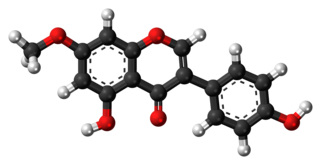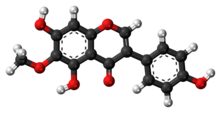Isoflavones are substituted derivatives of isoflavone, a type of naturally occurring isoflavonoids, many of which act as phytoestrogens in mammals. Isoflavones are produced almost exclusively by the members of the bean family, Fabaceae (Leguminosae).

Kaempferol (3,4′,5,7-tetrahydroxyflavone) is a natural flavonol, a type of flavonoid, found in a variety of plants and plant-derived foods including kale, beans, tea, spinach, and broccoli. Kaempferol is a yellow crystalline solid with a melting point of 276–278 °C (529–532 °F). It is slightly soluble in water and highly soluble in hot ethanol, ethers, and DMSO. Kaempferol is named for 17th-century German naturalist Engelbert Kaempfer.

Daidzein is a naturally occurring compound found exclusively in soybeans and other legumes and structurally belongs to a class of compounds known as isoflavones. Daidzein and other isoflavones are produced in plants through the phenylpropanoid pathway of secondary metabolism and are used as signal carriers, and defense responses to pathogenic attacks. In humans, recent research has shown the viability of using daidzein in medicine for menopausal relief, osteoporosis, blood cholesterol, and lowering the risk of some hormone-related cancers, and heart disease. Despite the known health benefits, the use of both puerarin and daidzein is limited by their poor bioavailability and low water solubility.

A leopard pattern is a spotted color pattern, particularly in the hair coat or skin of animals, but can also describe spotting patterns in plants and a distinctive print appearing on clothing and other fabrics.

Daidzin is a natural organic compound in the class of phytochemicals known as isoflavones. Daidzin can be found in Japanese plant kudzu and from soybean leaves.

Puerarin, one of several known isoflavones, is found in a number of plants and herbs, such as the root of the kudzu plant

Irigenin is an O-methylated isoflavone, a type of flavonoid. It can be isolated from the rhizomes of the leopard lily, and Iris kemaonensis.

ψ-Tectorigenin is an O-methylated isoflavone, a type of flavonoid. It can be isolated from Belamcanda chinensis, Dalbergia sissoo. It can also be isolated from the bacterium Nocardiopsis sp, and from the mold Stemphilium sp. No. 644.

Iridin is an isoflavone, a type of flavonoid. It is the 7-glucoside of irigenin and can be isolated from several species of irises like orris root, Iris florentina or Iris versicolor, also commonly known as the larger blue flag. It can also be found in Iris kemaonensis.

Tectoridin is an isoflavone, a type of flavonoid. It is the 7-glucoside of tectorigenin and can be isolated from flowers of Pueraria thunbergiana (Leguminosae).
The O-methylated flavonoids or methoxyflavonoids are flavonoids with methylations on hydroxyl groups. O-methylation has an effect on the solubility of flavonoids.

Iris domestica, commonly known as leopard lily, blackberry lily, and leopard flower, is an ornamental plant in the family Iridaceae. In 2005, based on molecular DNA sequence evidence, Belamcanda chinensis, the sole species in the genus Belamcanda, was transferred to the genus Iris and renamed Iris domestica.

Prenylated flavonoids or prenylflavonoids are a sub-class of flavonoids. They are widely distributed throughout the plant kingdom. Some are known to have phytoestrogenic or antioxidant properties. They are given in the list of adaptogens in herbalism. Chemically they have a prenyl group attached to their flavonoid backbone. It is usually assumed that the addition of hydrophobic prenyl groups facilitate attachment to cell membranes. Prenylation may increase the potential activity of its original flavonoid.

Irilone is an isoflavone, a type of flavonoid. It can be found in Trifolium pratense, in Iris unguicularis and in Iris germanica.

Prunetin is an O-methylated isoflavone, a type of flavonoid. It has been isolated for the first time by Finnemore in 1910 in the bark of Prunus emarginata. Prunetin isolated from pea roots can act as an attractant for Aphanomyces euteiches zoospores. It is also an allosteric inhibitor of human liver aldehyde dehydrogenase.

Iris tectorum is a plant species in the genus Iris, it is also in the subgenus Limniris. It is a rhizomatous perennial. It is native of China, Korea and Burma, with lavender-blue, bluish-violet, purple-blue, blue-lilac or sky blue flowers. There is a white form as well. It is a compact plant and is cultivated as an ornamental plant in temperate regions of the world.

Iris unguicularis, the Algerian iris, is a rhizomatous flowering plant in the genus Iris, native to Greece, Turkey, Western Syria, and Tunisia. It grows to 30 centimetres (12 in), with grassy evergreen leaves, producing pale lilac or purple flowers with a central band of yellow on the falls. The flowers appear in winter and early spring. They are fragrant, with pronounced perianth tubes up to 20 cm (7.9 in) long.
Iris bungei is a beardless iris in the genus Iris, in the subgenus Limniris and in the series Tenuifoliae of the genus. It is a rhizomatous herbaceous perennial, from Mongolia, Tibet and China. It has green leaves, short stem and 2 violet, purple, lavender or blue flowers.

Mirificin, also known as daidzein 8-C-(6-apiofuranosylglucoside), is an isoflavone that is found in Pueraria mirifica and Pueraria lobata. It has estrogenic activity and hence is a phytoestrogen.

















